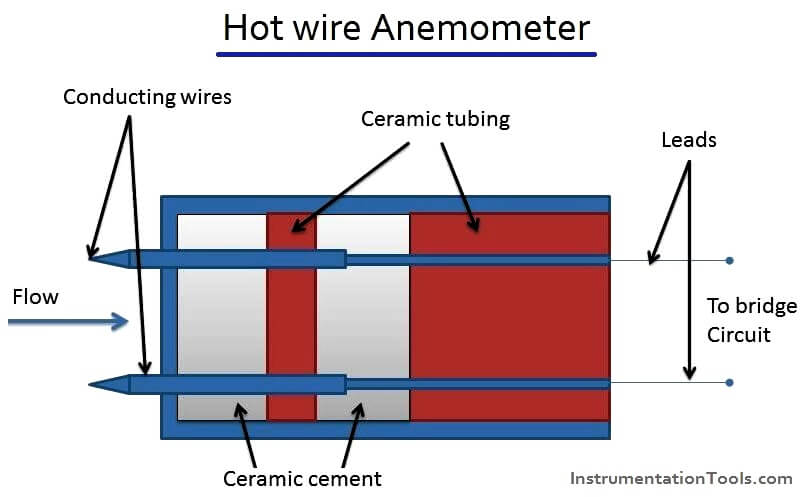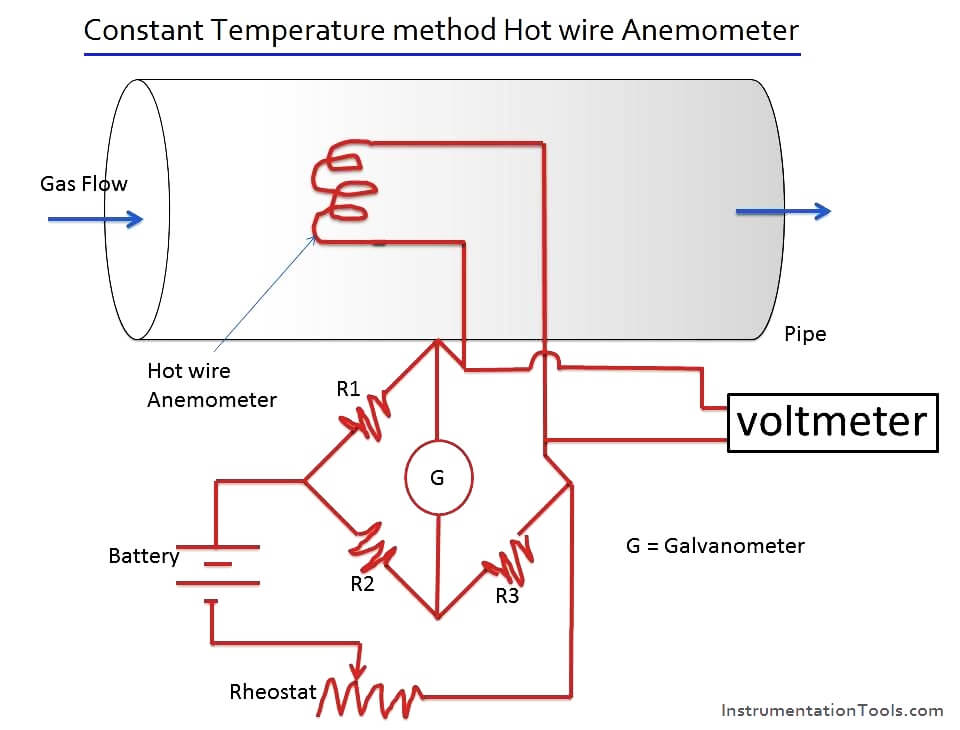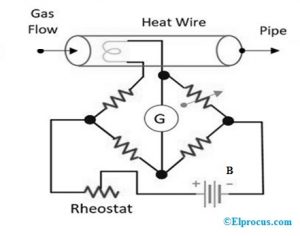Both of these attachments connect to. PowerPoint PPT presentation free to view.
Ppt Hot Wirehot Film Anemometer Powerpoint Presentation Free To View Id F0d7c Zdc1z
Hotwire anemometers determine the rate of cooling by either the constant current or the.
. In a standard hot-wire anemometer a thin wire is heated to a temperature above ambient by running an electrical current through it. In addition to its hotwire probe the versatile TPI 575C1 around 225 is equipped with a vane meter as a second means of determining wind speed in a higher velocity range. These are used as wind speed instruments in the meteorology sector.
The National Academies Press. Suggested CitationA Hot-wire Anemometer with Thermocouple National Research Council. Air compressor can be added FiO2 21.
Hot wire anemometer consists of a platinum-tungsten wire with diameter 5 pm of short length and stretched between two supports. The sensor may either be a thin wire suspended between two prongs or a thin metal film deposited on an electrically insulating substrate. The stream of air or gas is kept perpendicular to wire.
Hot Wire Anemometer Principle. Film sensors can be cylindrical fiber-film probes or non-cylindrical film probes. The mainframe use a bright LCD display to display 4 channels simultaneously using a 5.
In the 15th century Leon Battista Alberti invented the first mechanical anemometer. Hot Wire Anemometer Equation. The Hot Wire Anemometer is a device used for measuring the velocity and direction of the fluid.
These sensors typically use a second unheated temperature sensor to compensate for variations in the air temperature. The main parts of the. The wire is heated by electrical current.
Typical dimensions of the wire sensor are 000015 to 00002 inches 00038 to 0005 mm in diameter and 0040 to 0080 inches 10 to 20 mm long. To calculate the heating current the temperature stays as persistent so that the bridge stays in equilibrium. This change in resistance of the wire becomes a measure of flow rate.
Thus this book focuses on its detailed applications to fundamental fluid mechanics issues with a brief. There are many styles of anemometers including windmill cup and sonic but this Project is based on the concept of a hot-wire anemometer. As the electrical resistance of most metals is dependent upon the temperature of the metal tungsten is a popular choice for hot-wires a relationship can be obtained between the resistance of the wire and the.
Cup anemometers use the basics of rotational velocity for measuring wind speed but many flavors of anemometers exist including thermal vane ultrasonic and hot wire. This wire acts as a sensor. As the fluid velocity increases the rate of heat flow from the heated wire to the flow stream increases.
PowerPoint PPT presentation. It is important to use these products only in proper environments. 1 Where denotes the wires electric resistance and the electric current flowing through the wire.
Each sensor requires its own anemometer bridge. If a particulate was to hit this wire at a high velocity the device. In this device there will be a direct transfer of heat from the wire to liquid when kept in the liquid flow.
This can be done by measuring the heat loss of the wire which is placed in the fluid stream. After a short period of time the wire will reach an equilibrium temperature such that the heat energy coming. Thus a cooling effect on the wire electrode occurs causing its electrical resistance to change.
In this video we will discuss what is Hot Wire Anemometer Working Principle and Its Construction and Working What are its applicationsTimestamps000 - Sta. This wire of platinum-tungsten sensor is welded between the two prongs of probe. A hot wire anemometer is one kind of device used to measure the speed and direction of the wind.
Hot wire anemometers use a fine wire on the order of several micrometres electrically heated to some temperature above the ambient. Hot-wire anemometers utilize a small open tipped probe with a thin wire going across the opening. Figure 1 shows a hot-wire anemometer probe.
The hot-wire anemometer principally used in gas flow measurement consists of an electrically heated fine platinum wire which is immersed into the flow. A hot-wire anemometer consists of two probes with a wire stretched between them. The Hot-Wire Anemometer channels Can work in CTA Constant Temperature Anemometer mode as well as CCA Constant Current Anemometer mode with Option 11.
The hot wire anemometer calculates wind speed by determining the heat loss of the wire while the sensor is positioned in the wind stream to be measured. The heat generated by an electric wire is given by the relationship. This wire picks up readings by sending a small signal through itself to measure the dissipation of that signal.
A hot-wire anemometer is a device used to measure flow velocity based on the heat dissipated from a very thin electrically-heated wire. Yaw calibration is carried out with zero birnormal. The most essential part of the hot-wire anemometer is the thin wire sensor where forced convective heat transfer takes place from the wire to flow over the wire.
A small glass-coated thermistor bead is often used on constant-tem-perature circuit versions. The wire sensor is heated electrically and. This is the type of hot wire that has been used for such measurements as turbulence.
To know the temperature level of the wire about resistance a wheat stone bridge is used. Hot Wire Anemometers use the principle that the impact of wind will have a cooling effect on the wire. Thermal or hot wire anemometers use the principle that the amount of heat removed from a heated temperature sensor by a flowing fluid can be related to that fluids velocity.
The wire is usually made of tungsten platinum or platinum-iridium 1. Hot-wire anemometers while extremely delicate have extremely high frequency-response and fine spatial resolution compared to other measurement methods and as such are almost universally employed for the detailed study of turbulent flows or any flow in which rapid velocity fluctuations are of interest. A comprehensive review can be found in Perry 1982 and Lomas 1986.
The hot wire when placed in the stream of the fluid in that case the heat is transferred from wire to. A hot-wire anemometer is a device that heats a wire by pumping current through. Figure 1 below shows several different examples of hot-wire anemometers.
The Papers and Discussion of a Symposium on Pyrometry Held by the American Institute of Mining and Metallurgical Engineers at Its Chicago Meeting September 1919. The electric resistance depends on the wires. After several modifications John Thomas Romney Robinson in 1846 improved the design by using.
Principles of Mechanical Ventilation - 50 psig airoxygen gas sources. The system has a built-in microprocessor with Parallel communication and data acquisition capabilities. Wire sensors are used in gases and in non-conducting liquids while film.
Hot Wire Anemometer works When an electrically heated wire is placed in a flowing gas stream heat is transferred from the wire to the gas and hence the temperature of the wire reduces and due to this the resistance of the wire also changes. Air flowing past the wire cools the wire. Its sensitivity to C4 and a found to be manily due to a misalignment of yaw angle.
Well focus on the theory behind the operation of a cup anemometer as shown in Fig.

Hot Wire Anemometer Principle Instrumentation Tools

Anemometer Instrument Britannica

Hot Wire Anemometer Principle Instrumentation Tools

Air Flow Measurement How Hot Wire Anemometer Works F1

Hot Wire Anemometer Construction Working Its Applications

Hot Wire Anemometer Working Principle Application Flow Rate Measurement Animation Video Youtube

Ventilator Hot Wire Anemometer Flow Sensor Arabic Narration Youtube

0 comments
Post a Comment